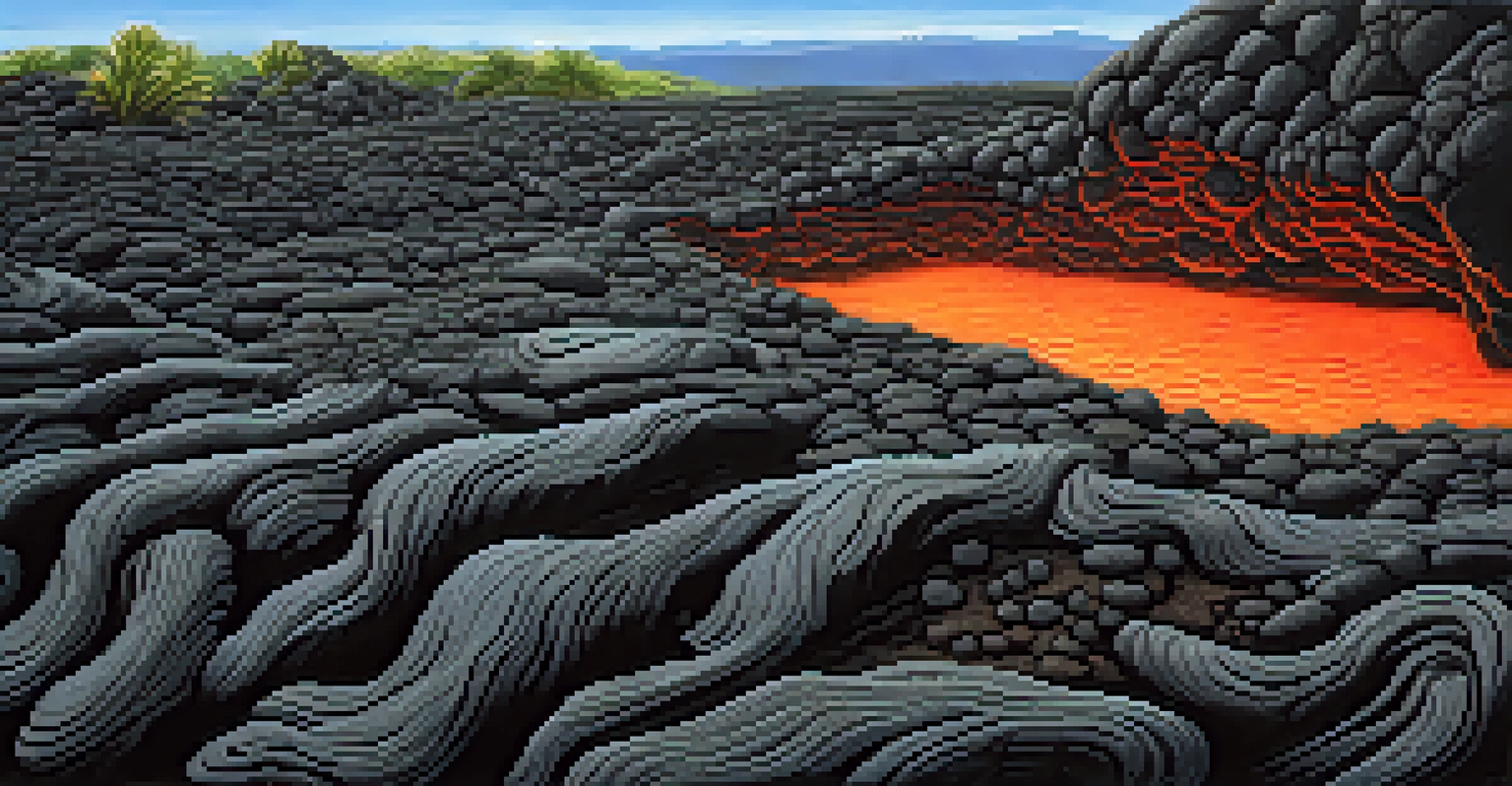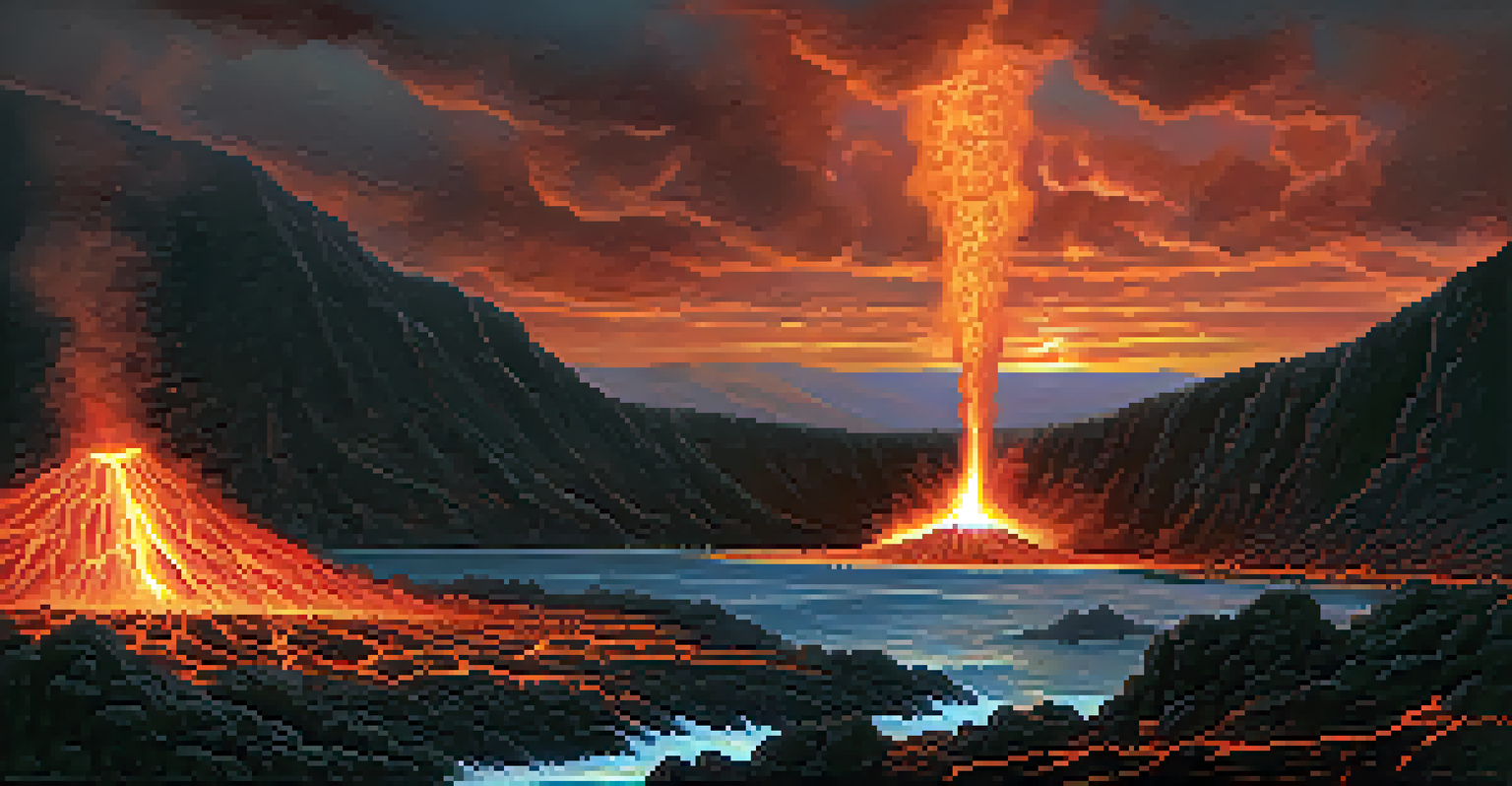Volcanic Activity and Its Influence on Hawaii's Geography Today

Understanding Hawaii's Volcanic Origins
Hawaii's geographical identity is deeply rooted in its volcanic origins. The Hawaiian Islands were formed by a series of underwater volcanic eruptions, which over millions of years created the land we see today. Each island represents a different stage in this volcanic activity, showcasing a fascinating timeline of geological processes.
Volcanoes are the most important geological process in the Hawaiian Islands, creating land and altering ecosystems in a continuous cycle of destruction and renewal.
The formation of the islands began with the Hawaiian hotspot, a stationary plume of magma that creates volcanoes as tectonic plates move over it. This hotspot has given rise to the eight main islands, with the Big Island currently experiencing active volcanic activity. Understanding this origin helps us appreciate the dynamic nature of Hawaii's landscape.
Today, the ongoing volcanic activity continues to shape the islands, affecting everything from the soil composition to the ecosystems that thrive here. As new land emerges from the ocean, it creates opportunities for unique plant and animal life, further enhancing Hawaii's biodiversity.
The Role of Shield Volcanoes in Hawaii
Hawaii is home to shield volcanoes, which are characterized by their broad, gently sloping sides. These types of volcanoes are formed by the eruption of low-viscosity lava that can flow over great distances. Mauna Loa and Mauna Kea are prime examples, and their massive structures dominate the landscape.

The gradual buildup of lava flows from these shield volcanoes has created expansive plateaus and fertile lands. This not only influences the geography but has also allowed agriculture to flourish. Farmers benefit from the rich volcanic soil, which is ideal for growing crops like coffee, sugarcane, and tropical fruits.
Hawaii's Unique Volcanic Formation
The Hawaiian Islands were formed by underwater volcanic eruptions, creating diverse geological features and ecosystems.
Moreover, the unique shape of shield volcanoes contributes to the islands' scenic beauty, attracting tourists from around the world. The combination of lush vegetation and dramatic volcanic landscapes makes Hawaii a paradise for nature lovers and adventurers alike.
Impact of Eruptions on Land Formation
Each volcanic eruption in Hawaii significantly alters the landscape, producing new land and features. For instance, the 2018 Kilauea eruption dramatically reshaped the Big Island's coastline, adding new land as lava met the ocean. These eruptions create new geological formations, such as lava tubes and craters.
The lava flows from Hawaii's volcanoes tell a story of creation, where new land is born, and life finds a way to thrive in the most challenging of environments.
The creation of new land also affects local ecosystems, as species must adapt to changing environments. Some plants and animals thrive on fresh lava, while others struggle to survive in these harsh conditions. This constant cycle of destruction and renewal fosters a unique ecological balance in Hawaii.
Additionally, these eruptions can have social and economic impacts, displacing communities and disrupting tourism. However, they also provide opportunities for research and education about geology and ecology, helping us understand these powerful natural processes.
The Influence of Lava Flows on Geography
Lava flows play a crucial role in shaping Hawaii's topography. When lava erupts and flows down the sides of volcanoes, it creates a variety of landforms, including valleys, cliffs, and new coastlines. These formations contribute to the islands' distinct landscapes, making Hawaii visually captivating.
The cooling and solidifying of lava results in unique geological features, such as pahoehoe (smooth lava) and aa (rough lava). Each type of flow shapes the land differently, influencing everything from soil type to water drainage patterns. This diversity in landforms contributes to Hawaii's rich array of ecosystems.
Impact of Eruptions on Ecosystems
Volcanic eruptions shape Hawaii's landscapes and ecosystems, fostering both destruction and renewal within the environment.
Over time, the combination of volcanic activity and erosion has sculpted Hawaii's dramatic scenery. The interplay between lava flows and natural forces like wind and water creates an ever-evolving landscape, reminding us that nature is always at work.
Volcanoes and Hawaii's Ecosystems
Hawaii's unique ecosystems are intricately linked to its volcanic activity. The islands host an array of plant and animal species that have adapted specifically to the volcanic environment. This includes endemic species found nowhere else on Earth, highlighting the islands' ecological significance.
As new land is formed, it creates habitats for pioneering species that can colonize barren lava fields. Over time, these pioneers help build soil and create conditions suitable for a broader range of plants and animals to thrive. This process illustrates the resilience of nature in adapting to volcanic landscapes.
However, the delicate balance of these ecosystems can be threatened by invasive species and environmental changes. Conservation efforts are crucial to preserving Hawaii's unique biodiversity, ensuring that future generations can enjoy the rich natural heritage shaped by volcanic activity.
Human Interaction with Volcanic Landscapes
Humans have interacted with Hawaii's volcanic landscapes for centuries, both positively and negatively. Ancient Polynesians revered volcanoes, incorporating them into their cultural practices and beliefs. Many sites hold historical significance, showcasing the deep connection between people and the land.
In contemporary times, volcanoes are both a source of fascination and a potential threat. Communities around active volcanoes must remain vigilant and prepared for eruptions, while also embracing the beauty and resources these landscapes provide. The balance between safety and appreciation is crucial for residents and visitors alike.
Human Connection to Volcanoes
Hawaiians have a deep cultural relationship with volcanoes, balancing reverence for these natural wonders with the need for safety.
Tourism plays a significant role in the local economy, with many visitors drawn to Hawaii's volcanic attractions, such as the Hawaii Volcanoes National Park. This interest in volcanoes not only supports local businesses but also raises awareness about the importance of respecting and preserving these natural wonders.
Looking Forward: Future Volcanic Activity
As we look to the future, the potential for volcanic activity in Hawaii remains a vital topic of discussion. Scientists continually monitor the islands for signs of eruptions, utilizing advanced technology to predict and mitigate risks. This ongoing research is essential for ensuring the safety of residents and visitors.
Moreover, understanding volcanic patterns helps scientists learn more about Earth's geology and climate. The insights gained from studying Hawaii's volcanoes can inform broader geological theories and contribute to our understanding of volcanic activity worldwide.

As new eruptions reshape the landscape, they will undoubtedly continue to influence Hawaii's geography and ecosystems. Embracing this dynamic relationship can help us appreciate the beauty and power of nature while fostering a sense of responsibility to protect these unique environments.